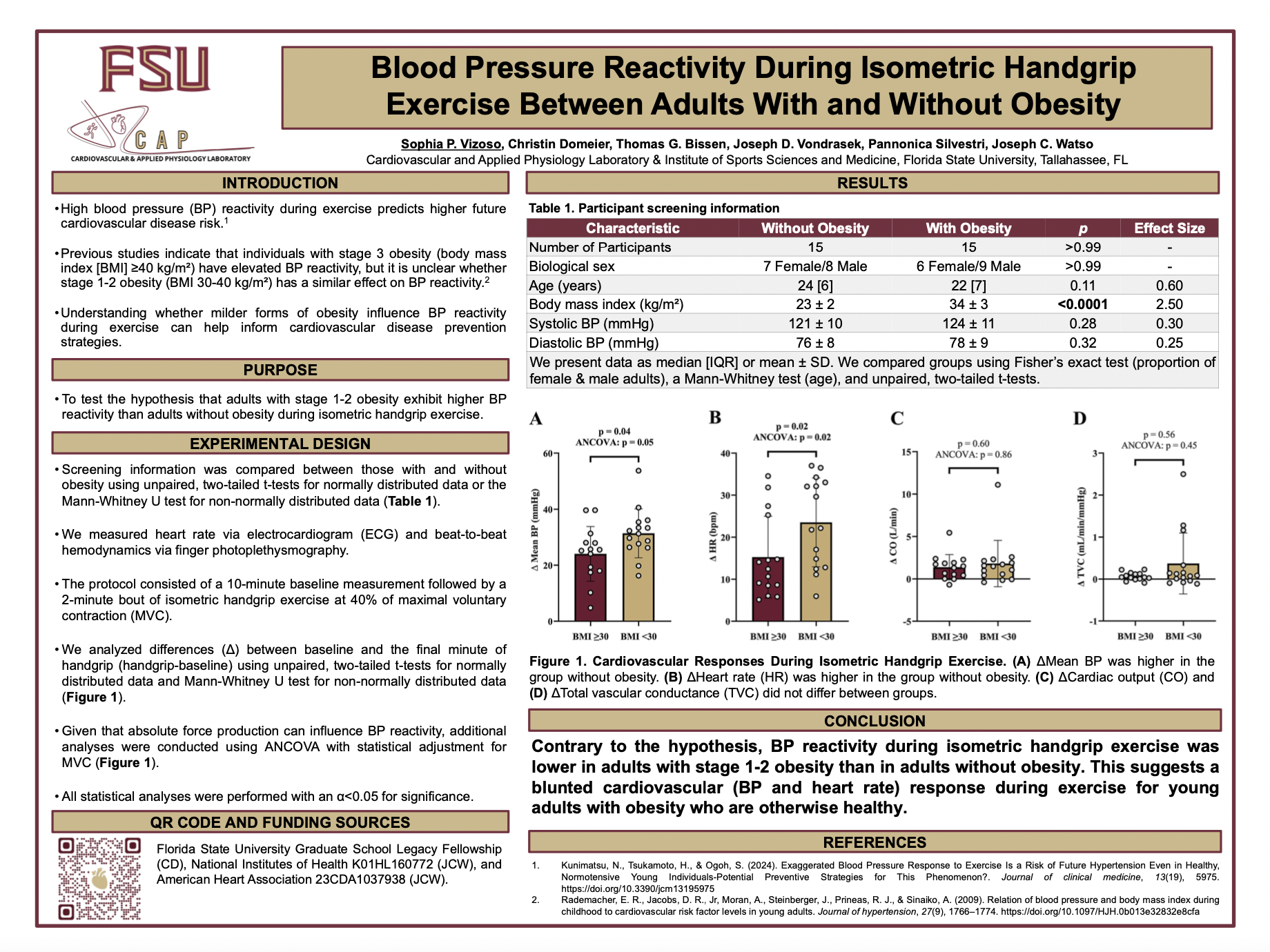Research Symposium
25th annual Undergraduate Research Symposium, April 1, 2025
Sophia Vizoso Poster Session 4: 3:00 pm - 4:00 pm/ Poster #189

BIO
My name is Sophia Vizoso, and I am a junior at Florida State University pursuing dual degrees in Cell and Molecular Neuroscience and Public Health. My research focuses on human health, particularly how genetic factors, underlying diseases, and diet interact to impact cardiovascular function. I have worked in the Cardiovascular & Applied Physiology Lab, analyzing physiological data to better understand health disparities. As a future physician, I aim to bridge clinical practice and public health to improve healthcare access and patient outcomes. My goal is to contribute to research-driven, patient-centered care that addresses both individual health and broader systemic challenges in medicine.
Blood Pressure Reactivity During Isometric Handgrip Exercise Between Adults With and Without Obesity
Authors: Sophia Vizoso, Joseph C. WatsoStudent Major: Cell and Molecular Neuroscience and Public Health
Mentor: Joseph C. Watso
Mentor's Department: Institute of Sports Sciences and Medicine Mentor's College: Health, Nutrition, and Food Sciences Co-Presenters:
Abstract
Background: High blood pressure (BP) reactivity during exercise predicts higher cardiovascular disease risk. Individuals with stage 3 obesity (body mass index[BMI] >40 kg/m²) have higher BP reactivity. However, whether stage 1-2 obesity (BMI 30-40 kg/m²) is associated with higher BP reactivity is less clear. Therefore, we tested the hypothesis that adults with stage 1-2 obesity would exhibit higher BP reactivity during isometric handgrip exercise compared to those without obesity. Methods: We measured beat-to-beat hemodynamic (photoplethysmography) and heart rate (electrocardiogram) in participants without obesity (BMI <30 kg/m²) and with stage 1-2 obesity (BMI 30-40 kg/m²) during a 10-minute baseline and a 2-minute bout of isometric handgrip exercise at 40% of maximal voluntary contraction (MVC). Differences (Δ; handgrip minute two-baseline) were compared using unpaired, two-tailed analyses and ANCOVA (MVC as covariate) and reported as with versus without obesity (mean±SD or median[IQR] for non-normal data [p<0.05 Shapiro-Wilk test]). Results: BMI (n=15, 34±3 vs. n=15, 23±2 kg/m², p<0.0001), but not age (22[7] vs. 24[6] years, p=0.11) or resting mean BP (89±7 vs. 87±7 mmHg, p=0.33) differed between groups. During handgrip, Δmean BP (Δ31±9 vs. ∆24±10 mmHg; p=0.04; ANCOVA p=0.05) and Δheart rate (Δ22[19] vs. Δ12[11] bpm; p=0.02 ANCOVA p=0.02) were higher in adults without obesity. ΔCardiac output and Δtotal vascular conductance were not different between groups (p≥0.56; ANCOVA p≥0.45). Conclusion: Contrary to our hypothesis, BP reactivity was higher in participants without versus with obesity during isometric handgrip exercise. These findings suggest that BMI alone may not be associated with BP reactivity during exercise.
Keywords: Exercise Physiology, Cardiovascular System, Health


